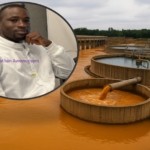
Galamsey and the Cost of Production: Illegal Mining Threatens Ghana’s Industries.
When we talk about galamsey, the conversation often ends with water pollution, forest loss, and public health. But there is another victim we rarely discuss Ghana’s industries. The factories that rely on clean water, consistent electricity, and predictable supply chains are quietly bearing the cost of illegal mining. These costs ripple outward, showing up in the price of cement, the cost of soap, the availability of beverages, and even the price of medicines in our pharmacies.
Water-Dependent Industries Under Siege
Manufacturing is thirsty work. Breweries, beverage companies, textile mills, and food processors need thousands of cubic meters of water daily. When galamsey muddies our rivers, the Ghana Water Company is forced to spend more on treatment and passes the extra cost to industrial customers. Some plants have had to shut down production temporarily because turbidity was too high for safe operations, or because municipal water supply was rationed. For companies with thin profit margins, every day of downtime means losses that can trigger layoffs or price increases.
In 2022, beverage manufacturers warned that rising water tariffs and unreliable supply were undermining their ability to compete. Galamsey is part of that story: it has turned once-reliable rivers like the Pra and Offin into near-toxic soup, forcing government and industry alike to spend more to make water usable.
Consider this: The Ghana Water Company Limited (GWC) has said that the rising amount of galamsey-polluted water has forced them to spend far more on treatment chemicals. They now budget around GHS 336 million for chemicals alone, a massive increase compared to past years. This jump is largely attributed to the extra purification work needed because of sediment, heavy metals, and general degradation of water sources. The Kwanyako Headworks (Central Region) has been completely shut down after silt from upstream galamsey operations choked its intake pumps. That plant produced over 25,000 cubic metres of water per day before the shutdown. Also, a plant supplying about 75% of potable water to Tarkwa, Ghana’s large mining hub, was forced to shut down due to pollution in the River Bonsa caused by illegal mining
Pharmaceutical and Food Safety Risks
Pharmaceutical industries are especially vulnerable. Clean water is a critical input for drug manufacturing, from paracetamol to intravenous fluids. Any contamination, mercury, arsenic, lead can compromise Good Manufacturing Practice (GMP) standards and risk rejection of entire batches for safety reasons.
When drug makers are forced to invest in extra filtration, testing, and quality assurance, those costs eventually land on patients. The rising cost of essential medicines is not only about global inflation or exchange rates, but also about the hidden expense of purifying what galamsey has polluted.
Food processors face a similar challenge. Cocoa grinders, fruit canneries, and poultry feed producers must test their inputs for contaminants. If cadmium in cocoa or mercury in cassava exceeds international thresholds, export contracts may be suspended, hurting foreign exchange earnings and threatening jobs.
The Pharmaceutical Society of Ghana has warned that local pharmaceutical manufacturers are increasingly burdened by polluted raw water. They need more expensive treatment technology for water used in drug production. Because of water quality degradation, local production of intravenous infusions and other sterile products is under threat
The Trail Effect: Electricity, Logistics, and Beyond
Galamsey also affects the trail, the network of infrastructure and energy that keeps factories running. Mining near power lines and roads leads to frequent disruptions, while illegal excavation has been known to damage feeder roads, raising haulage costs for manufacturers. Small-scale miners sometimes even tap power illegally from the national grid, contributing to system losses that utilities then recover by raising tariffs for legitimate customers including industries.
The result? The manufacturing sector squeezed between higher input costs and reduced competitiveness. If factories pass on the costs, prices rise; if they absorb them, profitability falls and layoffs follow.
The Wider Economic Risk
Ghana is working hard to industrialize under initiatives like One District, One Factory. But galamsey threatens to make that effort more expensive and less attractive to investors. No investor wants to put millions into a plant that might have to shut down because its water source has become unusable or because its product might fail export quality checks due to contaminated inputs. This is more than an environmental issue, it is a macroeconomic risk. A country that cannot guarantee basic utilities or safe raw materials will struggle to grow its manufacturing base, keep jobs, and stabilize prices.
A National Reflection
The cost of galamsey is not just in the destroyed forest or polluted river; it is hidden in every sachet of water, every loaf of bread, every tablet of paracetamol. If we allow our water sources to degrade, the price of production will keep climbing and Ghanaians will keep paying more for the essentials of life.
The question we must confront is: how much more are we willing to pay before we demand an end to this destruction?

